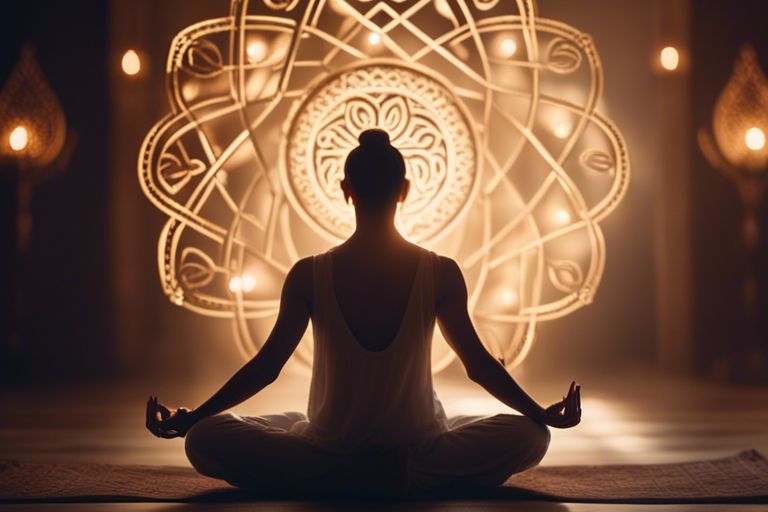Over the centuries, Kundalini yoga has remained a mystical and intriguing practice, shrouded in ancient wisdom and spiritual significance. As you probe into the origins and practices of Kundalini yoga, you will discover a transformative journey that awakens your dormant energy, guiding you towards self-realization and enlightenment. Explore the intriguing elements of this powerful practice and unlock the secrets of Kundalini yoga that have fascinated seekers and spiritual enthusiasts for generations.
Key Takeaways:
- Kundalini Yoga Origins: Kundalini Yoga dates back to ancient India and is rooted in the teachings of the Tantric and Vedic traditions. It involves the awakening of Kundalini energy located at the base of the spine.
- Unique Practices: Kundalini Yoga incorporates dynamic movements, breathing techniques (pranayama), chanting (mantra), meditation, and specific body postures (asanas) which are distinct from other forms of yoga.
- Spiritual Transformation: Practitioners of Kundalini Yoga believe that by awakening and harnessing the Kundalini energy, one can experience spiritual growth, emotional balance, and a deeper connection to the self and the universe.
1. Kundalini yoga awakens dormant energy within the body.
2. Combines breathwork, movement, and meditation for spiritual practice.
3. Originates from ancient spiritual traditions in India.
4. Aims to achieve a heightened state of consciousness.
5. Utilizes mantras, mudras, and specific kriyas for energy shifts.
6. Offers profound physical, mental, and emotional benefits to practitioners.
The Ancient Roots of Kundalini Yoga
While exploring the intriguing world of Kundalini Yoga, it’s important to investigate its ancient roots to truly understand its profound significance. This ancient practice has its origins deeply rooted in Hinduism and Tantric philosophy, dating back thousands of years.
Origins in Hinduism and Tantric Philosophy
Kundalini, derived from the Sanskrit word meaning “coiled serpent,” symbolizes the dormant energy located at the base of the spine. According to Hindu and Tantric traditions, this powerful energy is believed to be coiled like a snake ready to be awakened through the practice of Kundalini Yoga. The practice aims to channel this energy through the body’s seven chakras, or energy centers, to achieve spiritual enlightenment and self-realization.
The Role of Kundalini Energy in Indian Mythology
Energy, in Indian mythology, plays a significant role in the form of the goddess Shakti. Shakti represents the divine feminine energy and is often depicted as a serpent coiled at the base of the spine. When awakened through the practice of Kundalini Yoga, this energy rises through the chakras, ultimately uniting with the masculine energy of Shiva at the crown chakra, leading to a state of bliss and ultimate enlightenment.
Another vital aspect of Kundalini energy in Indian mythology is its association with the creative force of the universe. It is believed that by awakening this dormant energy within you, you can tap into your creative potential and unleash a profound sense of connection with the world around you.

The Science Behind Kundalini Yoga
Now, let’s research into the science behind Kundalini Yoga. This ancient practice is not just about physical postures and breathing techniques; it taps into deeper realms of energy within the body that have profound effects on your well-being.
The Concept of Kundalini Energy and its Effects on the Body
The concept of Kundalini energy originates from the belief that there is a dormant energy coiled at the base of your spine. Through specific yoga practices such as breathwork, chanting, and meditation, this energy is believed to rise through the chakras, the energy centers in the body. As Kundalini energy ascends, it can bring about a range of physical, mental, and emotional effects, leading to greater awareness, creativity, and spiritual enlightenment.
The Connection between Kundalini Yoga and the Nervous System
Yoga has a direct impact on the nervous system, and Kundalini Yoga is no exception. The practice involves stimulating the nervous system through dynamic movements, breath control, and meditation. This stimulation can help regulate the stress response, increase parasympathetic activity (the rest-and-digest mode), and enhance overall brain function. By working with the nervous system, Kundalini Yoga can help you manage stress, improve focus, and cultivate a sense of inner peace.
Concept
By understanding the intricate connection between Kundalini Yoga and the nervous system, you can begin to tap into the powerful effects this practice can have on your mind and body. Through regular practice, you can regulate your energy flow, enhance your mental clarity, and access deeper states of consciousness. Embrace the science behind Kundalini Yoga to unlock the full potential of this transformative practice.

The Practices of Kundalini Yoga
Unlike the physical-focused nature of many other forms of yoga, Kundalini yoga incorporates a diverse range of practices aimed at awakening the dormant energy within you. If you want to explore more about the origins and practices of Kundalini yoga, you can visit About Kundalini Yoga on the Kundalini Research Institute website.
Breathing Techniques and Meditation
Practices in Kundalini yoga often involve specific breathing techniques, known as pranayama, that help to activate and move the Kundalini energy. These techniques are combined with meditation practices to enhance focus, clarity, and connection to your inner self.
Postures and Movements to Awaken Kundalini Energy
On your Kundalini yoga journey, you will engage in specific postures and movements that are designed to activate the energy stored at the base of your spine. These movements help to stimulate the flow of Kundalini energy through the chakras, promoting physical, mental, and spiritual well-being.
Movements in Kundalini yoga are often repetitive and rhythmic, allowing you to experience a deep sense of meditation in motion. As you flow through these postures and movements, you may feel the Kundalini energy rising up through your body, bringing a sense of awakening and vibrancy to your being.
The Importance of Mantras and Sound in Kundalini Yoga
To deepen your practice, Kundalini yoga incorporates the use of mantras and sound vibrations. Chanting specific mantras or listening to sacred sounds can help to elevate your energy and consciousness, allowing you to connect with higher states of awareness and inner peace.
For instance, the chanting of “Sat Nam,” which translates to “Truth is my identity,” is a common mantra used in Kundalini yoga to align the practitioner with their true self and the universal truth. These sacred sounds have a powerful effect on your mind, body, and spirit, helping you to resonate with the higher frequencies of the universe.

The Benefits of Kundalini Yoga
All
Physical Health Benefits: Flexibility, Strength, and Balance
Kundalini Yoga offers numerous physical health benefits. Through the practice of asanas (yoga poses) and kriyas (repetitive movements), you can increase your flexibility, strength, and balance. The dynamic movements in Kundalini Yoga help to stretch and strengthen your muscles, improve your range of motion, and enhance your overall physical well-being.
Emotional
Mental and Emotional Benefits: Reduced Stress and Anxiety
Engaging in Kundalini Yoga can also provide significant mental and emotional benefits, including the reduction of stress and anxiety. The combination of breathwork, meditation, and chanting in Kundalini Yoga helps to calm your mind, release tension, and promote a sense of inner peace and relaxation.
Another
Spiritual Benefits: Increased Awareness and Connection to Self
One of the profound benefits of Kundalini Yoga lies in its ability to deepen your spiritual awareness and foster a stronger connection to your true self. By incorporating meditation, mantra chanting, and spiritual teachings into your practice, you can heighten your consciousness, cultivate self-love, and develop a deeper understanding of your purpose in life.
Anxiety
Overall, the practice of Kundalini Yoga offers a holistic approach to health and well-being, addressing not only the physical body but also the mind, emotions, and spirit. Whether you seek to improve your physical fitness, reduce stress, or deepen your spiritual connection, Kundalini Yoga has something to offer for everyone on their journey of self-discovery and transformation.
The Role of the Guru in Kundalini Yoga
The Importance of a Qualified Teacher in Kundalini Yoga
Qualified teachers play a pivotal role in guiding you through the intricate practices of Kundalini Yoga. They have undergone rigorous training and have a deep understanding of the subtle energies at play during these practices. A qualified teacher can provide you with the necessary tools and techniques to navigate the awakening of the Kundalini energy safely and effectively.
The Guru-Disciple Relationship in Kundalini Yoga Tradition
In Kundalini Yoga, the relationship between the guru (teacher) and disciple is sacred. The guru serves as a spiritual guide, leading the disciple on the path to self-realization and enlightenment. This relationship is based on trust, respect, and devotion. The guru imparts not only knowledge but also transmits a subtle energy known as shaktipat, which can awaken the dormant Kundalini energy within the disciple.
Relationship with the guru in Kundalini Yoga tradition goes beyond a mere teacher-student dynamic. It is a deep, personal connection where the guru guides the disciple through the challenges and pitfalls of the spiritual journey, helping them navigate the complexities of the inner world.
Modern Adaptations and Controversies
Despite the ancient roots of Kundalini yoga, its modern adaptations and controversies have brought both fervent followers and skeptical critics. If you want to investigate deeper into the frequently asked questions about Kundalini yoga, you can explore more on Kundalini Yoga’s FAQ.
The Evolution of Kundalini Yoga in the Western World
Western interpretations of Kundalini yoga have led to a fusion of traditional practices with more contemporary elements. In the Western world, Kundalini yoga has gained popularity for its dynamic kriyas, which are sets of exercises, breathwork, and mantra chanting designed to awaken the kundalini energy. This style often incorporates music, dance, and meditative practices to create a unique and powerful experience for practitioners.
Criticisms and Misconceptions about Kundalini Yoga
About Kundalini yoga, there are various criticisms and misconceptions that exist in both spiritual and scientific communities. Some skeptics question the safety and efficacy of Kundalini yoga practices, raising concerns about the intensity of the kundalini energy awakening process and its effects on physical and mental well-being. Additionally, misconceptions about Kundalini yoga being associated with cults or esoteric practices have further fueled skepticism around this ancient tradition.
It is necessary to approach these criticisms and misconceptions with an open mind and seek guidance from experienced teachers and practitioners who can provide insights into the true essence of Kundalini yoga. Understanding the nuanced practices and philosophy behind Kundalini yoga can help dispel misunderstandings and allow you to explore its transformative potential with clarity and discernment.
Conclusion
The journey into Kundalini Yoga is a path of self-discovery and transformation. By delving deep into the unknown origins and practices of this ancient tradition, you have opened the doors to a world of spiritual awakening and inner enlightenment. As you continue to explore and embrace the teachings of Kundalini Yoga, remember that the true essence of this practice lies within you. The power to unleash your fullest potential and connect with the divine energy rests in your hands. Embrace the unknown, dive deep into the depths of your being, and let Kundalini Yoga guide you on a journey of self-realization and awakening.
FAQ
Q: What is Kundalini Yoga?
A: Kundalini Yoga is a spiritual and physical practice that aims to awaken the Kundalini energy located at the base of the spine. This ancient form of yoga focuses on breathing techniques, dynamic movements, meditation, and chanting to help balance the mind, body, and spirit.
Q: What are the origins of Kundalini Yoga?
A: Kundalini Yoga originated in India thousands of years ago and was passed down through the teachings of gurus and sages. It was brought to the West by Yogi Bhajan in the late 1960s, who founded the 3HO (Healthy, Happy, Holy Organization) to make the practice more accessible to people around the world.
Q: What are the benefits of practicing Kundalini Yoga?
A: Practicing Kundalini Yoga can have numerous benefits, including increased flexibility, stress relief, improved focus and concentration, enhanced creativity, and a greater sense of inner peace and well-being. It is also believed to help activate the energy centers in the body, leading to a deeper spiritual connection and self-awareness.











